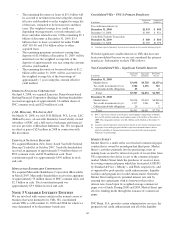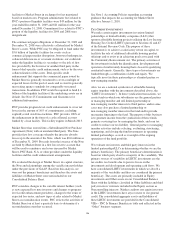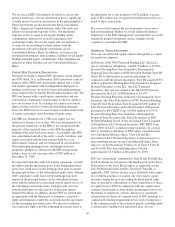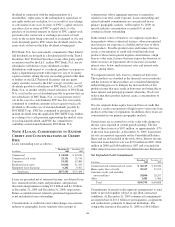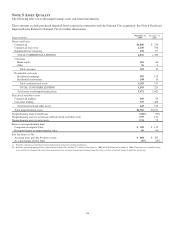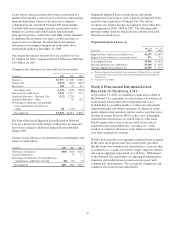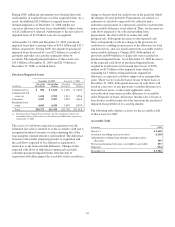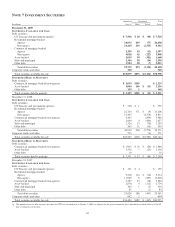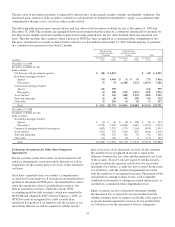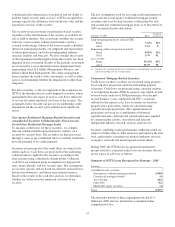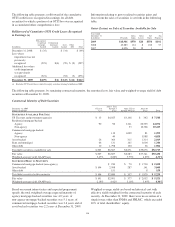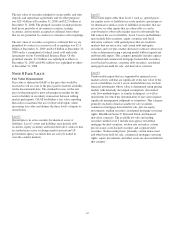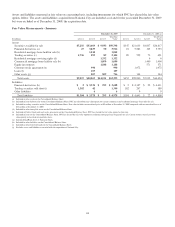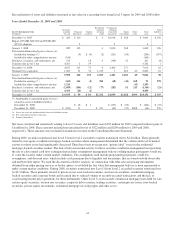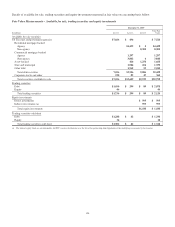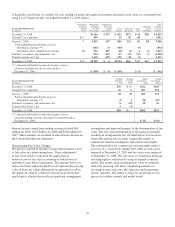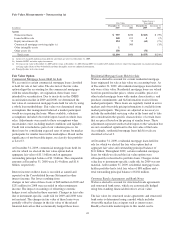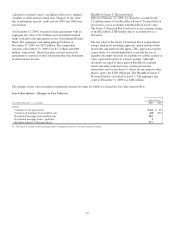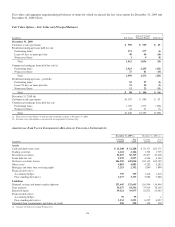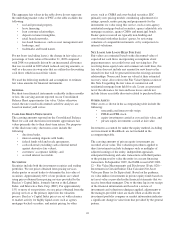PNC Bank 2009 Annual Report Download - page 119
Download and view the complete annual report
Please find page 119 of the 2009 PNC Bank annual report below. You can navigate through the pages in the report by either clicking on the pages listed below, or by using the keyword search tool below to find specific information within the annual report.
consideration the estimated recovery period and our ability to
hold the equity security until recovery, OTTI is recognized in
earnings equal to the difference between the fair value and the
amortized cost basis of the security.
The security-level assessment is performed on each security,
regardless of the classification of the security as available for
sale or held to maturity. Our assessment considers the security
structure, recent security collateral performance metrics,
external credit ratings, failure of the issuer to make scheduled
interest or principal payments, our judgment and expectations
of future performance, and relevant independent industry
research, analysis and forecasts. We also consider the severity
of the impairment and the length of time the security has been
impaired in our assessment. Results of the periodic assessment
are reviewed by a cross-functional senior management team
representing Asset & Liability Management, Finance, and
Balance Sheet Risk Management. The senior management
team considers the results of the assessments, as well as other
factors, in determining whether the impairment is other-than-
temporary.
For debt securities, a critical component of the evaluation for
OTTI is the identification of credit-impaired securities, where
management does not expect to receive cash flows sufficient
to recover the entire amortized cost basis of the security. The
paragraphs below describe our process for identifying credit
impairment for the security types with the most significant
losses.
Non-Agency Residential Mortgage-Backed Securities and
Asset-Backed Securities Collateralized by First-Lien and
Second-Lien Residential Mortgage Loans
To measure credit losses for these securities, we compile
relevant collateral details and performance statistics on a
security-by-security basis. The securities are then processed
through a series of pre-established filters to identify bonds that
have the potential to be credit impaired.
Securities not passing all of the credit filters are subjected to
further analysis. Cash flows are projected for the underlying
collateral and are applied to the securities according to the
deal structure using a third-party default model. Collateral
cash flows are estimated using assumptions for prepayment
rates, future defaults, and loss severity rates. The assumptions
are security specific and are based on collateral characteristics,
historical performance, and future expected performance.
Based on the results of the cash flow analysis, we determine
whether we will recover the amortized cost basis of our
security.
The key assumptions used for assessing credit impairment on
prime and Alt-A non-agency residential mortgage-backed
securities and asset-backed securities collateralized by first
and second-lien residential mortgage loans as of December 31,
2009 are detailed in the table below.
December 31, 2009 Range
Weighted-
average (a)
Long-term prepayment rate (annual CPR)
Prime 7-15% 12%
Alt-A 7-15 9
Remaining collateral expected to default
Prime 0-50% 16%
Alt-A 3-79 42
Loss severity
Prime 15-65% 45%
Alt-A 25-75 58
(a) Calculated by weighting the relevant assumption for each individual security by the
current outstanding cost basis of the security.
Commercial Mortgage-Backed Securities
Credit losses on these securities are measured using property-
level cash flow projections and forward-looking property
valuations. Cash flows are projected using a detailed analysis
of net operating income (NOI) by property type which, in turn,
is based on the analysis of NOI performance over the past
several business cycles combined with PNC’s economic
outlook for the current cycle. Loss severities are based on
property price projections, which are calculated using
capitalization rate projections. The capitalization rate
projections are based on a combination of historical
capitalization rates and expected capitalization rates implied
by current market activity, our outlook and relevant
independent industry research, analysis and forecasts.
Securities exhibiting weaker performance within the model are
subject to further analysis. This analysis is performed at the loan
level, and includes assessing local market conditions, reserves,
occupancy, rent rolls and master/special servicer details.
During 2009, the OTTI losses recognized in noninterest
income related to estimated credit losses on securities that we
do not expect to sell were as follows:
Summary of OTTI Losses Recognized in Earnings - 2009
In millions
Available for sale securities:
Non-agency residential mortgage-backed $(444)
Commercial mortgage-backed (6)
Asset-backed (111)
Other debt (12)
Marketable equity securities (4)
Total $(577)
The noncredit portion of these impairments totaled $1.4
billion for 2009 and was included in accumulated other
comprehensive loss.
115


